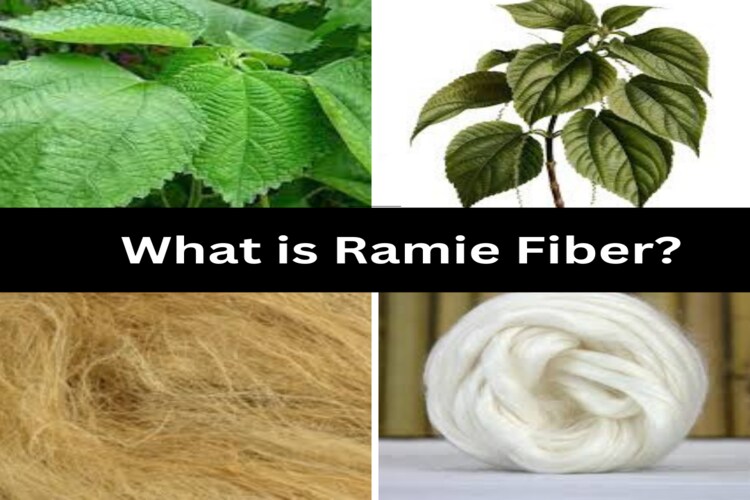What is Ramie fiber?
Ramie is a sustainable plant fiber from the nettle family, making it eco-friendly due to its biodegradability, unlike synthetic petroleum-based fabrics. The fibers in Ramie have a textured appearance that makes it resemble linen. What’s remarkable is that Ramie fiber is said to be “twice as strong” as linen fiber, which is already known for its strength, and it retains this strength even when wet.
History of Ramie fiber
Ramie, one of the oldest textile fibers, is believed to have originated in the Malay Peninsula. Its natural resistance to bacteria and mildew has made it valuable, with historical evidence of its use in Egypt around 5000-3000 BC, particularly for making mummy cloths. Chinese farmers, known as “zhuma” have been cultivating and using Ramie for clothing over the centuries. In the late 1930s, Brazil began growing ramie plants, but due to competition from soybeans and synthetic fibers, its production declined. By the 1950s, the Philippines also adopted ramie cultivation. Taiwanese communities have a tradition of using ramie in fabric production, creating their traditional clothing, known as “garb,” often worn during festivals. Ramie fiber is used to make “mechera,” an open-weave fabric suitable for crafting shirts and dressing gowns, particularly for warmer climates. The renowned French painter Raoul Dufy used this fabric for printing various patterns in the early 20th century.
Properties of Ramie fiber
- In terms of physical attributes, Ramie fibers vary in length, ranging from 40 to 200 mm, with a diameter of about 25-30 μm.
- Ramie fiber is excellent in terms of absorbency, making it exceptionally comfortable to wear, especially in hot climates.
- Ramie fiber stands out for its strength, being nearly six times stronger than cotton and twice as strong as flax. Additionally, it becomes even stronger when exposed to moisture.
- On the downside, Ramie fibers have relatively low resistance to abrasion.
- In terms of chemical durability, Ramie fiber can withstand mild acids and is resistant to alkalis. However, prolonged exposure to strong acids or alkalis can weaken the fiber and lead to cellulose hydrolysis.
- It has a moisture regain rate of around 12%.
Structure of Ramie
Ramie fibers are long and glossy, naturally white, and have a silky look. Ramie fiber similar to cotton, linen, and other plant fibers, ramie is a type of cellulosic material. What sets ramie apart is its inner structure, differing from other plant fibers with polymeric carbohydrate elements. Ramie fiber has a unique physical form; it’s rigid and crystalline, yet remarkably porous. This distinctive structure gives ramie exceptional absorbency, surpassing many other cellulose-based fibers.
Chemical Composition
- Cellulose: 68.6 – 76.2%
- Lignin: 0.6 -0.7%
- Hemi-cellulose: 13.1 – 16.7%
- Pectin: 1.9%
- Wax: 0.3%
Processing of Ramie fiber
The best time to harvest ramie is when the seeds have formed, and the flowers are falling. This can be done by hand or with mechanical harvesters. If the ribbons aren’t removed immediately after harvesting, it’s important to dry the stalks to prevent bacterial attacks. Following the harvest, decortication, which involves removing the outer bark, central woody core, gums, and waxes from the ramie stems, should be done promptly. If decortication can’t be completed on the same day, it’s necessary to keep the stalks moist by sprinkling water until the process can be completed. Drying the stalks in advance would hinder decortication, so the harvest schedule often depends on the decortication machine’s capacity. During decortication, the stalks are fed through a feeding mouth, which leads them to beaters that crush the stalks. The crushed stalks are then pushed onto a delivery plate and separated manually. The quality of the fiber depends on the plant’s condition and the operator’s skill. After extraction, the fiber needs to be washed. Following this, it should either be dried or degummed to prevent the growth of mildew.
Advantages of Ramie
- It resists bacteria, mildew, and various insects effectively.
- Dyeing ramie fiber is easy and straightforward.
- Ramie fiber is often mixed with different types of fibers in blends.
- It has remarkable absorbency properties.
- Ramie fibers become stronger when they get wet.
- The luster of ramie fibers improves with each wash.
- It maintains its shape well and doesn’t shrink.
- Ramie fiber and fabric can be bleached with success.
- Lastly, ramie fiber is commonly used alongside other fibers.
Disadvantages of Ramie
- May have a stiff and brittle feel.
- Lacks a good drape.
- Low durability.
- Minimal elasticity.
- Can be challenging to handle.
- Prone to creasing.
- Manufacturing can be expensive.
Use of Ramie fiber
- Its high tensile strength makes ramie fiber valuable in industrial uses, like producing twine, cordage, and ropes.
- Some cultures use ramie to create traditional clothing and household items such as mats and baskets.
- In agriculture, ramie works as a natural pesticide, effectively managing pests and diseases.
- Ramie’s environmental impact is positive due to its biodegradability, providing a sustainable alternative to synthetic fibers in applications like soil erosion control and cleaning up oil spills.
- Ramie is used in the textile industry for various products, including clothing, industrial sewing threads, linens, and home furnishings.
You may also like:
- Explore The Different Types Of Textile Fibers
- Structure and Properties of Cotton Fiber
- Kapok Fiber: Properties, Structure and Production Process
- What is Linen Fiber? Properties, Structure, and How It Made?
- What is Jute Fiber? Properties, Advantages and Disadvantages.
- Hemp Fiber : Properties, Advantages and Disadvantages.
- Coir Fiber: Properties, Production Process and Advantages
- Wool Fiber: History, Properties, Production Process
Share this Article!

